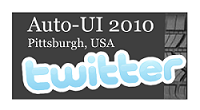Following the first two successful conferences
on
Automotive User Interfaces and Interactive
Vehicular Applications we are proud to announce
a
call for papers on this topic for
a
Theme issue
of the
Springer Journal on Personal and Ubiquitous Computing.
Hide Box
In-car electronic devices are becoming ubiquitous. Drivers and passengers use these devices because they perceive them as providing a valuable service. Some of these devices, such as collision warning systems, assist drivers in performing the primary task in a vehicle which is driving. Others provide information on myriad subjects or entertain the driver and passengers. A problem that arises from the proliferation of in-car devices is that they may distract drivers from the primary task of driving, with possibly disastrous results. Thus, one of the three major goals of the Automotive UI 2010 conference is to explore ways in which in-car user interfaces can be designed so as to avoid distracting the driver while still providing a valuable service. This is a challenging task, especially given that the design of in-car devices, which was historically the responsibility of car manufacturers and OEMs, is now a shared responsibility between a large and ever-changing group of parties. This group includes the car manufacturers and OEMs, but also the designers of devices that are brought in to the car, such as portable personal navigation devices and MP3 players.
As we consider driving safety, our focus in designing in-car user interfaces should not be purely on eliminating distractions. In-car devices with carefully designed user interfaces may also provide an opportunity to improve the driverís performance and hopefully the safety of driving. The second major goal of Automotive UI 2010 is to explore approaches to designing in-car user interfaces that will accomplish exactly this.
Finally, some in-car devices, such as rear-seat entertainment systems, are aimed purely at passengers. The third major goal of Automotive UI 2010 is to explore the design of interfaces for these devices.

